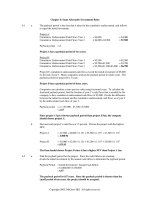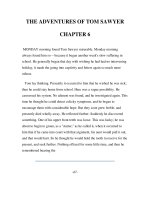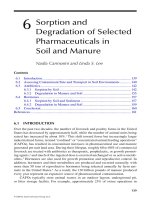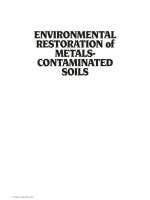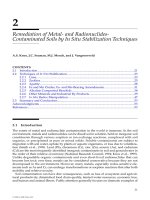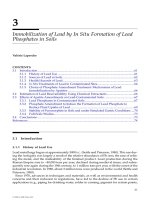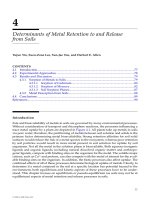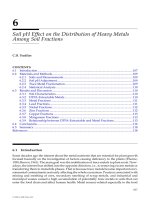ENVIRONMENTAL RESTORATION of METALSCONTAMINATED SOILS - CHAPTER 6 ppt
Bạn đang xem bản rút gọn của tài liệu. Xem và tải ngay bản đầy đủ của tài liệu tại đây (316.55 KB, 13 trang )
107
6
Soil pH Effect on the Distribution of Heavy Metals
Among Soil Fractions
C.D. Tsadilas
CONTENTS
6.1 Introduction 107
6.2 Materials and Methods 109
6.2.1 Soils and Measurements 109
6.2.2 Soil pH Adjustment 109
6.2.3 Trace Metal Fractionation 109
6.2.4 Statistical Analysis 110
6.3 Results and Discussion 110
6.3.1 Soil Characteristics 110
6.3.2 DTPA-Extractable Metals 110
6.3.3 Metal Fractions 111
6.3.4 Lead Fractions 111
6.3.5 Nickel Fractions 112
6.3.6 Zinc Fractions 112
6.3.7 Copper Fractions 113
6.3.8 Manganese Fractions 113
6.3.9 Relationship between DTPA-Extractable and Metal Fractions 113
6.4 Conclusions 116
6.5 Summary 118
References 118
6.1 Introduction
Some decades ago the interest about the metal nutrients that are essential for plant growth
focused basically on the investigation of factors causing deficiency to the plants (Thorne,
1959; Brown, 1961). The main goal was the mobilization of trace metals to plant roots. Now-
adays, the interest has shifted into the opposite direction, i.e., to removing excess metals or
transferring them to immobile phases. That is because trace metals became important envi-
ronmental contaminants seriously affecting the whole ecosystem. Practices associated with
mining and smelting of ores, secondary smelting of scrap metals, and industrial and
municipal wastes caused a high accumulation of potentially toxic metals to soils that can
enter the food chain and affect human health. Metal sources related especially to the food
4131/frame/C06 Page 107 Friday, July 21, 2000 4:56 PM
© 2001 by CRC Press LLC
108
Environmental Restoration of Metals–Contaminated Soils
chain are municipal sewage sludge, composts, swine and poultry manure, industrial
wastes, coal fly ash, and P fertilizers (Adriano et al., 1997). For mitigation of the conse-
quences caused by the use of metal containing materials, the responsible authorities
imposed restrictions in their use. The U.S. Environmental Protection Agency (U.S. EPA,
1993) as well as the European Union (CEC, 1986) imposed upper limits in the amount of
heavy metals permitted to be applied in the soils with sewage sludge. These restrictions
in general reflect soil factors that affect metal retention such as soil pH and cation
exchange capacity.
Remediation of soils contaminated with heavy metals is an important problem for many
countries throughout the world and concentrates the efforts of many authorities and scien-
tists. Treatment of soil contaminated with heavy metals is classified in three main catego-
ries, i.e., physical, chemical, and biological treatments (Iskandar and Adriano, 1997).
Physical processes include physical separation, carbon adsorption, frozen ground pro-
cesses, and thermal processes such as vitrification, incineration, cyclone furnace, and roast-
ing. Chemical processes aim at removing the metals or decreasing their availability to the
plants through which they enter the food chain. They include neutralization, precipitation,
solidification/stabilization, encapsulation, ion exchange, and washing. Finally, biological
processes utilize the ability of some plants to accumulate high amounts of heavy metals
into their tissues (“hyperacummulators”) for removing them from contaminated soils.
Neutralization of acidic or alkali soils is one of the most simple and inexpensive methods
used for immobilization of heavy metals. Solubility of all metals is strongly dependent on the
redox potential and pH (Sims and Patrick, 1978). With an exception of As, Se, and Mo, the
solubility of most metals decreases as pH increases reducing their availability. Zinc behavior
is sometimes different than the other metals. For example, McBride and Blasiak (1979)
reported that at pH values >7.5 soil solution Zn increases due to the formation of soluble-Zn
organic matter complexes.
Total heavy metal concentration is not a good indicator of metal availability to the plants.
Heavy metals in soils occur in various chemical forms with a different degree of availability
to the plants. Separation of various forms of heavy metals in soils is carried out using
sequential extraction techniques. Several such sequential extraction techniques are used for
studying the availability of metals to plants and their mobility and reactivity in soils and
sediments. These procedures utilize a number of selective extractants to solubilize metals
associated with various soil component fractions. By these techniques metals are usually
partitioned into exchangeable, carbonate, organic, iron and manganese oxides, and resid-
ual fractions (Shuman, 1979; Iyengar et al., 1981; Sposito et al., 1982; Emmerich et al., 1982;
Hickey and Kittrick, 1984; LeClaire et al., 1984; Tsadilas et al., 1995). From all the fractions
being determined, the one available to plants was found to be mainly the exchangeable
one, extracted usually with KNO
3
(Pierzynski and Schwab, 1993; LeClaire et al., 1984;
Sims, 1986), the organically bound fraction (Sims, 1986; Samaras and Tsadilas, 1997) or the
carbonate fraction (LeClaire et al., 1984; Samaras and Tsadilas, 1997).
The above-mentioned heavy metal forms do not remain constant in the soils. They dra-
matically change because of the change of many soil factors affecting their distribution such
as organic matter addition, metal addition, time, pH or Eh. These factors strongly influence
heavy metal forms, causing redistribution of them among the various soil components.
Therefore, in soil remediation practices, it is extremely important to know the influence of
each one factor on the distribution of heavy metals in order to transfer the maximum
amount of them into forms unavailable to plants.
Soil pH is one of the most important factors affecting heavy metal distribution among the
soil constituents, as was suggested by several workers. Sims (1986) found, for four soils var-
ied widely in organic matter content and cation exchange capacity, that below pH 5.2 the
dominant species of Mn, Cu, and Zn was the exchangeable one, while at pH values greater
4131/frame/C06 Page 108 Friday, July 21, 2000 4:56 PM
© 2001 by CRC Press LLC
Soil pH Effect on the Distribution of Heavy Metals Among Soil Fractions
109
than 5.2 the organically complexed and Fe-oxide bound forms dominated. Shuman (1986)
reported that liming decreased exchangeable Zn and increased organic fraction of Zn and
Mn. Neilsen et al. (1986) found in 20 orchard soils from British Columbia that soil acidifica-
tion caused a redistribution of soil Zn from the residual fraction into the exchangeable and
organic fractions. As soil pH manipulation through liming is a relatively simple and low cost
practice, it can be considered for remediation of soils contaminated with heavy metals. The
purpose of this chapter is to discuss soil pH influence on the distribution of some heavy met-
als, including lead (Pb), nickel (Ni), zinc (Zn), copper (Cu), and manganese (Mn), in some
strongly acid Greek soils to which sewage sludge was applied for their amelioration.
6.2 Materials and Methods
6.2.1 Soils and Measurements
Four surface (0 to 15 cm) soils, classified as Ultic Haploxeralfs, were selected from the Elas-
sona area located in the western part of central Greece. In this area, because of the high rain-
fall and the continuous application of acidifying nitrogen fertilizers for a long time, the soils
became strongly acid and their productivity was dramatically reduced. Soil liming is a
common practice in this area for the improvement of soil productivity. In recent years,
farmers started to use sewage sludge as a soil amendment. The samples were air dried,
crushed to pass a 2-mm sieve, and analyzed for the following: pH in a 1:1 water/soil sus-
pension (McLean, 1982), organic matter content with the wet oxidation procedure (Nelson
and Sommers, 1982), exchangeable aluminum with the aluminum method (Hsu, 1963) after
extraction with 1
M
KCl (Barnishel and Bertsch, 1982), and cation exchange capacity with
the NaOAc (pH 8.2) method (Rhoades, 1982). Total content of Pb, Ni, Cu, Zn, and Mn was
determined in extracts obtained from digestion of 2-g soil samples by 12.5 mL 4
M
HNO
3
at 80
°
C overnight (Sposito et al., 1982).
6.2.2 Soil pH Adjustment
Soil pH was adjusted to the desirable level using calcium oxide, and 200-g subsamples of
each soil were put in plastic pots and thoroughly mixed with various amounts of calcium
oxide to obtain the pH values of 4.0 to 8.4 (Table 6.2). Each treatment was replicated three
times. The samples were wetted up to the field capacity and incubated for 30 days at room
temperature in a complete randomized block design. During the incubation period soil
moisture was kept constant by adding deionized water after weighting. At the end of the
incubation period, soil pH was determined in a soil/water suspension of 1:1.
6.2.3 Trace Metal Fractionation
Trace metal fractionation was carried out using the procedure proposed by Emmerich et al.
(1982), but slightly modified. In brief, the procedure included the following: triplicate 2-g
samples were sequentially extracted with 0.5
M
KNO
3
for 16 h (exchangeable fraction), 0.5
M
NaOH for 16 h (organic fraction), 0.05
M
Na
2
-EDTA for 6 h (carbonate fraction), and 4
M
HNO
3
at 70 to 80°C for 16 h (residual fraction). Preliminary investigation showed that
extraction with water after the 0.5
M
KNO
3
extraction, as proposed by Emmerich et al. (1982),
4131/frame/C06 Page 109 Friday, July 21, 2000 4:56 PM
© 2001 by CRC Press LLC
110
Environmental Restoration of Metals–Contaminated Soils
did not extract a detectable amount of the metals studied, so this step was not included in the
fractionation procedure. Separate subsamples were also extracted with 0.005
M
DTPA solu-
tion adjusted to a pH 7.3 (Lindsay and Norvell, 1978). Heavy metals in the extraction solu-
tions were determined by atomic absorption spectrometry (AAS, Perkin-Elmer model 5000).
6.2.4 Statistical Analysis
For the evaluation of the influence of pH on the various metal forms the data were analyzed
using conventional analysis of variance considering them separately for each soil. In study-
ing the relationship between soil pH and heavy metal fractions simple regression analysis
or stepwise variable selection, forward elimination techniques were used.
6.3 Results and Discussion
6.3.1 Soil Characteristics
The basic physicochemical characteristics are shown in Table 6.1. The soils were sandy
loamy to loamy, strongly acidic, with a high concentration of exchangeable aluminum, low
organic matter content, and low cation exchange capacity. Soil pH after liming was raised
from 4.0 up to 8.4 (Table 6.2).
6.3.2 DTPA-Extractable Metals
The DTPA extraction procedure was proposed by Lindsay and Norvell (1978) for simulta-
neous extraction of the available iron, manganese, copper, and zinc mainly for near-neutral
and calcareous soils. Several workers reported a very good correlation between the concen-
tration of heavy metals extracted by this method and the respective concentrations in the
plants (Samaras and Tsadilas, 1997; Tsadilas et al., 1995). The correlation, however, was
more or less specific to the soil. The procedure was also successfully used for the determi-
nation of an index of the availability of Ni and cadmium (Cd) (Baker and Amacher, 1982).
In the present study, this procedure, in addition to the above-mentioned metals, was also
TABLE 6.1
Selected Physicochemical Properties of the Soils Studied
Property
Soils
S1 S2 S3 S4
Texture Sandy loam Sandy loam Loam Sandy loam
pH (H
2
0 1:1) 4.0 4.4 4.3 4.2
Exchangeable Al, mg kg
–1
95 87 92 94
Organic matter, g kg
–1
8.5 12.3 9.2 10.2
Cation exchange capacity, cmol(+) kg
–1
8.72 7.53 9.62 8.75
Total Pb, mg kg
–1
41.8 44.9 43.8 39.5
Total Ni, mg kg
–1
31.2 42.9 35.6 34.5
Total Zn, mg kg
–1
31.4 40.6 37.8 37.6
Total Cu, mg kg
–1
16.2 29.2 36.4 21.3
Total Mn, mg kg
–1
355 640 495 372
4131/frame/C06 Page 110 Friday, July 21, 2000 4:56 PM
© 2001 by CRC Press LLC
Soil pH Effect on the Distribution of Heavy Metals Among Soil Fractions
111
used for Pb extraction. Concentrations of heavy metals extracted by DTPA are presented in
Table 6.2. Soil pH increases, because of the soil liming, significantly affected the concentra-
tion of all the metals extracted except for Cu (Table 6.2). A very good negative correlation
was recorded between pH and their concentration. The higher correlation coefficient was
found for Mn (Figure 6.1). Similar observations were reported by several investigators
(Shuman, 1991). However, Schwab et al. (1990) found a positive relationship between soil
pH and Zn extracted by DTPA. They attributed this positive relationship to the chemistry
of the extracting solution rather than the chemistry of soil Zn.
6.3.3 Metal Fractions
There was a very good agreement between total concentration of heavy metals measured
directly by the HNO
3
acid digestion procedure and total heavy metal concentration calcu-
lated by the summation of the separate fractions (Tables 6.1 and 6.3). In all cases total heavy
metals measured by HNO
3
digestion tended to be a little lower than the summation of sep-
arate fractions. The same observations were reported by Sposito et al. (1982), who attrib-
uted these small differences in the higher effectiveness of the HNO
3
in the sequential
extraction procedure to previous extraction with NaOH and EDTA in the sequential extrac-
tion procedure.
6.3.4 Lead Fractions
Distribution of lead fractions is presented in Table 6.3. Exchangeable fraction in soils in
their original form ranged between 15 and 24%, organic matter fraction between 4 and 6%,
carbonate fraction between 23 and 25%, and the residual fraction between 41 and 43%. Soil
liming had a very small influence on the distribution of Pb fractions. Exchangeable and
organic fractions tended to decrease, the carbonate fraction remained almost constant, and
the residual fraction tended to increase. It seems therefore that a small amount of Pb tended
to shift from the exchangeable and organic fractions into the residual fraction. A positive
relationship was observed between residual Pb and soil pH (
r
= 0.60**).
TABLE 6.2
Soil pH and Concentration of Pb, Ni, Zn, Mn, and Cu (mg kg
–1
) Extracted by DTPA
a
Soil pH Pb Ni Zn Mn Cu
S1 4.00d
b
0.82a 0.55a 0.82a 40.51a 0.75a
6.60c 0.53b 0.17b 0.55b 15.50b 0.75a
7.50b 0.53b 0.17b 0.43b 9.41c 0.65a
8.20a 0.62b 0.23b 0.48b 7.19c 0.68a
S2 4.40d 0.84a 1.01a 0.92a 42.37a 1.88a
6.60c 0.65b 0.50b 0.53b 20.89b 2.02a
7.50b 0.70ab 0.42b 0.59b 17.54b 1.96a
7.90a 0.74ab 0.51b 0.51ab 12.83c 2.05a
S3 4.30d 1.16a 1.03a 1.14a 59.54a 2.59a
6.20b 0.98a 0.77ab 0.72b 33.01b 3.28a
7.30c 1.04a 0.51b 0.63b 26.66c 3.20a
7.70a 0.98a 0.54b 0.50b 22.28c 3.12a
S4 4.20d 0.92a 0.62a 0.99a 49.27a 1.99a
6.40c 0.60b 0.33b 0.44b 16.20b 1.47a
7.60b 0.57b 0.32a 0.49b 12.03c 1.18a
8.40a 0.66ab 0.38a 0.40b 10.94c 1.52a
a
Mean values of the three replicates.
b
Soil numbers in the same column followed by different letters differ significantly at the probability level
P
<0.05 according to the LSD test.
4131/frame/C06 Page 111 Friday, July 21, 2000 4:56 PM
© 2001 by CRC Press LLC
112
Environmental Restoration of Metals–Contaminated Soils
6.3.5 Nickel Fractions
Total Ni content ranged from 31.2 to 42.4 mg kg
–1
soil (Table 6.1). The distribution of Ni frac-
tions is shown in Table 6.3. The highest percentage of the total Ni (67 to 68%) was found in
the residual fraction. The exchangeable fraction ranged from 14 to 16%, the organic fraction
from 9 to 12%, and the carbonate fraction from 6 to 9%. Soil pH increase mainly affected the
exchangeable fraction, which was substantially reduced in all the soils. For example, in soil
S2, the exchangeable fraction at the original pH value of 4.4 decreased from 6.60 to
3.26 mg kg
–1
in the highest pH value. A significant negative relationship was found
between soil pH and exchangeable Ni (Figure 6.2). All the rest of the fractions tended to
increase slightly (Table 6.3).
6.3.6 Zinc Fractions
Total Zn ranged from 31.4 to 40.6 (Table 6.1) in the soils S1 and S2, respectively. The relative
distribution of Zn fractions is shown in Table 6.3. A percentage of 7 to 12% was found in the
exchangeable fraction, only 4% in the organic fraction, 11 to 14% in the carbonate fraction,
and the most in the residual fraction. The soil pH increase strongly affected exchangeable
FIGURE 6.1
Relationship between DTPA extractable Pb, Ni, Zn, and Mn with soil pH.
1.3
1.2
1.1
1
0.9
0.8
0.7
0.6
0.5
0.4
0.3
Pb-DTPA, mg kg
-1
-1
-1
y=-0.061x + 1.17
R =0.225*
2
R = 0.460**
2
Soil pH
3579
1.2
1
0.8
0.6
0.4
0.2
0
Soil pH
3579
1.2
1
0.8
0.6
0.4
0.2
0
Soil pH
3
5
7
9
y=-0.115x+1.26
Ni-DTPA, mg kg
Zn-DTPA, mg kg
-1
70
60
50
40
30
20
10
0
Soil pH
35
7
9
Mn-DTPA, mg kg
y = -0.629Ln(x) = 1.83
2
R = 0.62***
y = -9.348x + 85.96
2
R = 0.812***
4131/frame/C06 Page 112 Friday, July 21, 2000 4:56 PM
© 2001 by CRC Press LLC
Soil pH Effect on the Distribution of Heavy Metals Among Soil Fractions
113
Zn in all the soils. It was reduced mainly in the pH increase up to about 7.5. A strong neg-
ative relationship was found between soil pH and exchangeable Zn (Figure 6.2). Similar
results were reported by others (Sims, 1986; Shuman,1986). Organic fraction of Zn
remained unaffected, while carbonate fraction tended to increase and the residual fraction
was significantly increased. It seems, therefore, that soil pH increase causes a shifting of the
exchangeable Zn fraction into the residual fraction. These results are similar to those
reported by Neilsen et al. (1986), who found that a soil pH decrease with acidification
caused a shifting from the residual Zn fraction to the exchangeable fraction.
6.3.7 Copper Fractions
The main amount of Cu was found in organic and residual fractions. The organic fraction
of Cu ranged from 32 to 42% and the residual fraction from 31 to 46%. The exchangeable
fraction covered about 8 to 12% and the carbonated fraction 10 to 16% (Table 6.3). Several
workers found soil Cu to be associated with organic matter (Shuman, 1991). The increase
in soil pH significantly affected exchangeable and organic Cu fractions. The exchangeable
fraction was decreased significantly in all soils. The drop in this fraction was mainly from
pH 4.4 to 6.6. (Table 6.3, Figure 6.3). These results are in agreement with those reported by
Sanders et al. (1986) and Elsokkary and Lag (1978). Organic fraction was also decreased in
all soils except soil S3. A strong relationship was found between the concentration of Cu in
the exchangeable fraction and soil pH (Figure 6.2). The carbonate fraction was not signifi-
cantly influenced by pH change. It tended to increase but the increase was not statistically
significant except in soil S3. The same trend observed in carbonate fraction was recorded
for residual Cu fraction. The increase was significant only in the case of soil S4 and it was
observed in the soil at pH 6.4 (Table 6.3, Figure 6.3). So it seems that in soil a pH increase
decreases exchangeable and organic Cu fractions, causing a shifting of part into the carbon-
ate and residual fractions. However, because the amount of exchangeable and organic frac-
tions redistributed was not high, they didn’t significantly increase the other fractions.
6.3.8 Manganese Fractions
A significant percentage of Mn was found in the exchangeable fraction, which ranged from
16 to 32% (Table 6.3). The organic fraction covered only a very small percentage of Mn,
ranging from 0.1 to 2%. The carbonate fraction was found in a percentage of 22 to 47%,
while the most abundant fraction was the residual covering from 36 to 50% of the soil Mn.
Soil pH increase strongly affected Mn fraction distribution, causing a sharp decrease in
exchangeable fraction in the pH values from 4.0 to about 6.5. Above pH 6.5 very little
exchangeable Mn was detected. These findings are in close agreement with those reported
by Sims (1986). However, Sims (1986) as well as Shuman (1986) found that exchangeable
Mn was transformed into organic forms, while in the present study organic form was not
significantly affected. Exchangeable Mn was mainly transformed into carbonate and resid-
ual forms, which were significantly increased (Table 6.3, Figure 6.3). In agreement with
results reported by Sims (1986), a very strong relationship was recorded between soil pH
and exchangeable Mn (Figure 6.2).
6.3.9 Relationship between DTPA-Extractable and Metal Fractions
Several workers found that the DTPA test (Lindsay and Norvell, 1978) is effective in pre-
diction of plant available metals (Sims and Jonson, 1991). The knowledge of the pools, from
4131/frame/C06 Page 113 Friday, July 21, 2000 4:56 PM
© 2001 by CRC Press LLC
114
Environmental Restoration of Metals–Contaminated Soils
TABLE 6.3
Distribution of Soil Fractions of Pb, Ni, Zn, Cu, and Mn in Relation to Soil pH
Soil pH Exchangeable Organic Carbonate Residual Sum
(mg kg
–1
)
Pb
S1 4.00d
a
6.14a
b
6.55a 9.83a 18.42b 40.94a
6.60c 6.41a 5.21a 9.22a 19.23b 40.07a
7.50b 5.79a 4.97b 9.52a 21.11b 41.38a
8.20a 5.36a 5.36ab 9.08a 21.45b 41.25a
S2 4.40d 8.69a 6.08a 9.99a 18.68b 43.44a
6.60c 7.80a 4.33ab 10.83a 20.36ab 43.32a
7.70c 7.58a 4.01b 11.14a 21.84b 44.57a
7.90a 7.53a 3.99b 10.68a 22.16b 44.32a
S3 4.30d 9.28a 4.22a 10.55a 18.15a 42.20a
6.20b 8.56a 3.40b 10.28a 20.55a 42.82a
7.30c 8.00a 3.37b 10.11a 20.64a 42.13a
7.70a 7.75a 3.01b 11.20a 21.10a 43.07a
S4 4.20d 9.39a 4.70a 9.00a 16.04b 39.13a
6.40c 8.35a 3.42b 7.97a 18.22a 37.95a
7.60b 8.84a 3.46b 8.07a 18.07a 38.45a
8.40a 8.70a 3.40b 7.94a 17.78a 37.82a
Ni
S1 4.00d
a
4.67a 2.92a 1.75a 19.85a 29.19a
6.60c 3.39a 3.39a 2.26a 19.22a 28.26a
7.50b 3.54a 3.54a 2.07a 20.35a 29.5a
8.20a 3.60a 3.60a 2.40a 20.40a 30.00a
S2 4.40d 6.60a 3.71a 3.30b 27.64a 41.25a
6.60c 4.05ab 4.05a 4.45ab 27.91a 40.45a
7.50b 3.77b 4.61a 5.03b 28.51a 41.93a
7.90a 3.26b 4.07a 5.29b 28.08a 40.7a
S3 4.30d 4.73a 3.71a 3.04a 22.28a 33.75a
6.20b 3.07ab 4.44a 3.41a 23.21a 34.13a
7.30c 2.03b 4.40a 3.72a 23.67a 33.82a
7.70a 2.13b 4.61a 4.25a 24.45a 35.44a
S4 4.20d 4.28a 3.67a 2.45a 20.18a 30.57a
6.40c 2.64b 3.96a 3.30a 23.11a 33.01a
7.60b 2.89b 3.86a 3.21a 22.17a 32.13a
8.40a 2.59b 3.88a 3.23a 22.63a 32.33a
Zn
S1 4.00d
a
2.09a 1.20a 3.29a 23.31a 29.88a
6.60c 1.13b 1.13a 4.24a 21.75a 28.25a
7.50b 0.86b 1.15a 3.74a 23.00a 28.75a
8.20a 0.88b 1.46a 4.09a 22.77a 29.19a
S2 4.40d 3.19a 1.59a 5.18a 29.90a 39.87a
6.60c 1.13b 1.13a 5.65a 29.74a 37.64a
7.50b 0.76c 1.15a 6.50a 29.84a 38.26a
7.90a 0.75c 1.50a 6.74a 28.45a 37.44a
S3 4.30d 4.41a 1.47a 5.15a 25.73a 36.75a
6.20b 1.79b 1.44a 5.74a 26.91a 35.88a
7.30c 1.09c 1.45a 6.16a 27.56a 36.26a
7.70a 0.78c 1.56a 7.40a 29.21a 38.95a
S4 4.20d 3.25a 1.45a 5.06a 26.37a 36.13a
6.40c 0.75b 1.49a 5.59a 29.43a 37.25a
7.60b 0.71b 1.43a 5.35a 28.16a 35.64a
8.40a 0.71b 1.42a 5.68a 27.69a 35.5a
4131/frame/C06 Page 114 Friday, July 21, 2000 4:56 PM
© 2001 by CRC Press LLC
Soil pH Effect on the Distribution of Heavy Metals Among Soil Fractions
115
which DTPA solution extracts metals, is useful in managing soils with regard to the metal
nutrients. Therefore, prediction equations of the DTPA extractable metal concentrations as
a function of the metal fractions were developed, using a stepwise variable selection, for-
ward elimination, technique. In these equations, DTPA extractable metal concentration was
the independent variable and metal fractions concentration and soil pH were the depen-
dent variables. Only the variables that increased R
2
significantly entered the equation. The
equations derived are shown in Table 6.4. For Pb extracted by DTPA, only the exchangeable
fraction entered the equation. This fraction explained about 36% of its variance. It seems
therefore that DTPA extracts Pb mainly from forms residing in exchangeable sites. In the
case of Ni, 82.3% extracted by DTPA was explained by soil pH, and exchangeable and
organic fraction. From the relevant equation of Table 6.4 it is obvious that exchangeable and
TABLE 6.3 CONTINUED
Distribution of Soil Fractions of Pb, Ni, Zn, Cu, and Mn in Relation to Soil pH
Soil pH Exchangeable Organic Carbonate Residual Sum
(mg kg
–1
)
Cu
S1 4.00d
a
2.05a 5.46a 1.71a 7.85a 17.07a
6.60c 1.36b 5.00a 1.36a 7.42a 15.14a
7.50b 1.24b 4.65ab 1.55a 8.06a 15.50a
8.20a 1.23b 3.85b 1.99a 8.00a 15.38a
S2 4.40d 2.28a 11.38a 3.98a 10.81a 28.44a
6.60c 1.34b 10.15ab 4.01a 11.21a 26.70a
7.50b 1.39b 11.15a 4.18a 11.15a 27.88a
7.90a 1.37b 9.58b 4.93a 11.22a 27.37a
S3 4.30d 4.24a 14.83a 3.89b 12.36a 35.32a
6.20b 1.41b 15.11a 4.94b 13.70a 35.27a
7.30c 1.42b 15.31a 5.34ab 12.46a 35.60a
7.70a 1.49b 15.29a 6.71b 13.43a 37.30a
S4 4.20d 2.27a 8.66a 3.30a 6.40b 20.63a
6.40c 1.44b 7.59ab 2.26a 9.23a 20.50a
7.60b 1.38b 6.92b 2.37a 9.09a 19.77a
8.40a 1.42b 6.71b 3.05a 8.95a 20.33a
Mn
S1 4.00d
a
94.20a 3.49a 76.78b 174.50b 349a
6.60c 10.50b 3.50a 164.50a 161.50b 350a
7.50b 7.04b 3.52a 144.32a 197.12b 352a
8.20a 2.82c 0.70b 137.28a 211.20a 352a
S2 4.40d 102.10a 6.38a 299.86b 229.68c 638a
6.60c 19.10b 6.37a 382.20a 229.32c 637a
7.50b 0.63c 0.63b 374.06a 259.94b 634a
7.90a 0.63c 0.63b 347.60a 284.40a 632a
S3 4.30d 155.52a 9.72a 140.94b 184.68c 486a
6.20b 67.34b 4.81b 202.02a 206.83b 481a
7.30c 28.80c 4.80b 244.80a 201.60b 480a
7.70a 14.70d 4.90b 249.90a 220.50a 490a
S4 4.20d 110.10a 7.34a 99.09b 154.14b 367a
6.40c 7.40b 3.70b 177.60a 181.30a 370a
7.60b 3.65b 3.65b 178.85a 178.85a 365a
8.40a 3.68b 3.68b 169.28a 191.36a 368a
a
Soil numbers in the same column followed by different letters differ significantly at the probability level
P
<0.05 according to the LSD test.
b
Mean values of the three replicates.
4131/frame/C06 Page 115 Friday, July 21, 2000 4:56 PM
© 2001 by CRC Press LLC
116
Environmental Restoration of Metals–Contaminated Soils
organic fractions are the main available Ni forms. Nearly the whole variance of the DTPA-
extractable Zn (a percentage 98.8%) was explained by soil pH, carbonate, and residual frac-
tions. The relevant equation suggests that exchangeable and carbonate fractions are sources
of available Zn, while residual Zn contains unavailable Zn forms. For Cu, the main source
of the DTPA extractable is organic fraction, suggesting that this fraction is an available
form. Finally 90% of the variation of Mn extractable by DTPA was explained by pH and the
exchangeable fraction.
6.4 Conclusions
Soil pH increase by liming substantially decreases the exchangeable fractions of the metals
studied, especially of Mn, shifting it mainly into carbonate, organic, and residual fractions.
DTPA-extractable metals originate mainly from the exchangeable and organic fraction
and in the case of Zn, from the carbonate fraction. Soil liming decreases DTPA extractable
metal fractions.
FIGURE 6.2
Relationship between exchangeable Ni, Zn, Cu, and Mn with soil pH.
Ni-KNO , mg kg
-1
3
3
Soil pH
3
579
7.00
6.00
5.00
4.00
3.00
2.00
1.00
0.00
y = -0.545x + 7.14
R = 0.520**
2
Cu-KNO , mg kg
-1
Mn-KNO , mg kg
-1
3
Soil pH
Soil pH
3
579
4.50
4.00
3.50
3.00
2.50
2.00
1.50
1.00
.50
0.00
y = 10.752x
R = 0.676***
2
3
3
579
2
Zn-KNO , mg kg
-1
3
Soil pH
3
5
7
9
5.00
4.50
4.00
3.50
3.00
2.50
2.00
1.50
1.00
.50
0.00
y = 70.152x
-2.1822
R = 0.843***
2
-1.0269
y = -176.16Ln(x) + 365.18
R = 0.844***
180.00
160.00
140.00
120.00
100.00
80.00
60.00
40.00
20.00
0.00
4131/frame/C06 Page 116 Friday, July 21, 2000 4:56 PM
© 2001 by CRC Press LLC
Soil pH Effect on the Distribution of Heavy Metals Among Soil Fractions
117
FIGURE 6.3
Soil pH influence on the distribution of Mn, Zn, and Cu fractions (soil 1).
TABLE 6.4
DTPA Extractable Metal Concentration as a Function of Metal Fraction Concentration
a
DTPA Extractable Linear Stepwise Multiple Regression Equations
a
R
2
Pb Pb
DTPA
= 0.08 Pb
KNO3
b
0.360
a
Ni Ni
DTPA
= 0.12pH + 0.08 Ni
KNO3
+ Ni
NaOH
0.823
c
Zn Zn
DTPA
= 0.04 pH + 0.22 Zn
KNO3
+ 0.12 Zn
EDTA
– 0.02 Zn
Res
0.988
c
Cu Cu
DTPA
= –0.36 + 0.23 Cu
NaOH
0.946
c
Mn Mn
DTPA
= –47.31 + 7.92 pH + 0.53 Mn
KNO3
0.900
c
a
Only independent variables significant at the <0.05 probability level are included in the equations.
b
KNO
3
, NaOH, EDTA, Res denote the exchangeable, organic, carbonate, and residual fraction, respectively.
a,c
Significant at probability level 0.05 and 0.001, respectively.
4131/frame/C06 Page 117 Friday, July 21, 2000 4:56 PM
© 2001 by CRC Press LLC
118
Environmental Restoration of Metals–Contaminated Soils
6.5 Summary
Remediation of metal-contaminated soils is a serious problem and has attracted the interest
of many researchers. For soil remediation many methods and technologies are in use, most
of which are successful but costly for large fields. One of the most commonly used inexpen-
sive methods is soil liming, which increases soil pH and immobilizes heavy metals. In this
chapter the influence of soil pH on the distribution of lead (Pb), nickel (Ni), zinc (Zn), cop-
per (Cu), and manganese (Mn) was studied in four strongly acid Ultic Haploxeralfs from
Greece which were limed to a pH of about 4.0 to 8.4. After liming the above-mentioned met-
als in these soils were fractionated into exchangeable, organic, carbonate, and residual frac-
tions. The same metals were also determined using the DTPA method. Soil liming
significantly decreased all the DTPA extractable metals except Cu. From the metal fractions
determined, the exchangeable fraction was reduced because of the pH increase in all metals
except Pb. The amount of exchangeable forms lost was mainly transformed into the carbon-
ate or the residual fractions. The strongest influence was observed in Mn fractions. Soil pH
was negatively correlated with DTPA extractable metal and exchangeable fractions. Signif-
icant percentages of the variance of the DTPA extractable metal concentration were pre-
dicted by the exchangeable, organic, and carbonate fractions.
References
Adriano, D.C., J. Albright, F.W. Whicker, I.K. Iskandar, and C. Sherony, Remediation of soil contam-
inated with metals and radionuclide-contaminated soils, in
Remediation of Soils Contaminated
with Metals
, I.K. Iskandar and D.C.Adriano, Eds., Science Reviews, Northwood, 1997, 27.
Baker, D.L. and M.C. Amacher, Nickel, copper, zinc, and cadmium, in
Methods of Soil Analysis, Part 2,
Chemical and Microbiological Properties
, 2nd ed., A.L. Page et al., Eds., ASA SSSA, Madison, WI,
1982, 323.
Barnishel, R.B. and P.M. Bertsch, Aluminum, in
Methods of Soil Analysis, Part 2, Chemical and Micro-
biological Properties
, 2nd ed., A.L. Page et al., Eds., ASA SSSA, Madison, WI, 1982, 275.
Brown, J., Iron chlorosis in plants, in
Advances in Agronomy
, 13, 329, 1961.
(CEC) Council of the European Communities, Council Directive of 12 June 1986 on the Protection
of the environment, and in particular of the soil, when sewage sludge is used in agriculture
(86/278/EEC),
Official J. Eur. Communities
, No. L.181, 6, 1986.
Elsokkary, I.H. and J. Lag, Distribution of different fractions of Cd, Pb, Zn, and Cu in industrially
polluted and non-polluted soils of Odda Region, Norway,
Acta Agric. Scand.
, 28, 262, 1978.
Emmerich, W.E., L.J. Lund, A.L. Page, and A.C. Chang, Solid phase forms of heavy metals in sewage
sludge-treated soils,
J. Environ. Qual.
, 11, 178, 1982.
Hickey, M.G. and J.A. Kittrick, Chemical partitioning of cadmium, copper, nickel and zinc fractions
in soils and sediments containing high levels of heavy metals,
J. Environ. Qual.
, 13, 372, 1984.
Hsu, P.H., Effect of initial ph, phosphate, and silicate on the determination of aluminum with
aluminon,
Soil Sci.
, 96, 230, 1963.
Iskandar, I.K. and D.C. Adriano, Remediation of soils contaminated with metals — a review of
current practices in the U.S.A., in
Remediation of Soils Contaminated with Metals
, I.K. Iskandar
and D.C. Adriano, Eds., Science Reviews, Northwood, 1997, 1.
Iyengar, S.S., D.C. Martens, and W.P. Miller, Distribution and plant availability of soil zinc fractions,
Soil Sci. Soc. Am. J.
, 45, 735, 1981.
4131/frame/C06 Page 118 Friday, July 21, 2000 4:56 PM
© 2001 by CRC Press LLC
Soil pH Effect on the Distribution of Heavy Metals Among Soil Fractions
119
LeClaire, J.P., A.C. Chang, C.S. Levesque, and G. Sposito, Trace metal chemistry in arid-zone field
soils amended with sewage sludge. IV. Correlations between zinc uptake and extracted soil
zinc fractions, Soil Sci. Soc. Am. J., 48, 509, 1984.
Lindsay, W.L. and W.A. Norvell, Development of a DTPA test for zinc, iron, manganese, and copper,
Soil Sci. Soc. Am. J., 42, 421, 1978.
McBride, M.B. and J.J. Blasiak, Zinc and copper solubility as a function of pH in an acid soil, Soil
Sci. Soc. Am. J., 43, 1137, 1979.
McLean, E.O., Soil pH and lime requirement, in Methods of Soil Analysis, Part 2, Chemical and
Microbiological Properties, 2nd ed., A.L. Page et al., Eds., ASA SSSA, Madison, WI, 1982, 199.
Neilsen, D., P.B. Hoyt, and A.F. MacKenzie, Distribution of soil zinc fractions in British Columbia
interior orchard soils, Can. J. Soil Sci., 66, 445, 1986.
Nelson, D.W. and L.E. Sommers, Total carbon, organic carbon, and organic matter, in Methods of Soil
Analysis, Part 2, Chemical and Microbiological Properties, 2nd ed., A.L. Page et al., Eds., ASA SSSA,
Madison, WI, 1982, 539.
Pierzynski, G.M. and A.P. Schwab, Bioavailability of zinc, cadmium, and lead in a metal-contami-
nated alluvial soil, J. Environ. Qual., 22, 247, 1993.
Rhoades, J.D., Cation exchange capacity, in Methods of Soil Analysis, Part 2, Chemical and Microbiological
Properties, 2nd ed., A.L. Page et al., Eds., ASA SSSA, Madison, WI, 1982, 149.
Samaras, V. and C.D. Tsadilas, Distribution and availability of six heavy metals in a soil treated with
sewage sludge, in Proc. Int. Conf. Biogeochemistry of Trace Elements, Berkeley, CA, 1997, 145.
Sanders, J.R., T.M. Adams, and B.D. Christensen, Extractability and bioavailability of zinc, nickel,
cadmium, and copper in three Danish soils sampled 5 years after application of sewage sludge,
J. Soil Food Agric., 37, 1155, 1986.
Schwab, A.P., C.E. Owensby, and S. Kulyingyong, Changes in soil chemical properties due to 40 years
of fertilization, Soil Sci., 149(1), 35, 1990.
Shuman, L.M., Zinc, manganese, and copper in soil fractions, Soil Sci., 127(1), 10, 1979.
Shuman, L.M., Effect of liming on the distribution of manganese, copper, iron, and zinc among soil
fractions, Soil Sci. Soc. Am. J., 50, 1236, 1986.
Shuman, L.M., Chemical forms of micronutrients in soils, in Micronutrients in Agriculture,
J.J. Motvedt, F.R. Cox, L.M. Shuman, and R.M. Welsh, Eds., ASA SSSA, Madison, WI, 1991, 113.
Sims, J.T., Soil pH effects on the distribution and plant availability of manganese, copper, and zinc,
Soil Sci. Soc. Am. J., 50, 367, 1986.
Sims, J.L. and J.L. Patrick, Jr., The distribution of micronutrient cations in soil under conditions of
varying redox potential and pH, Soil Sci. Soc. Am. J., 42, 258, 1978.
Sims, J.T. and G.V. Jonson, Micronutrient soil test, in Micronutrients in Agriculture, J.J. Motvedt,
F.R. Cox, L.M. Shuman, and R.M. Welsh, Eds., ASA SSSA, Madison, WI, 1991, 427.
Sposito, G., L.J. Lund, and A.C. Chang, Trace metal chemistry in arid-zone field soils amended with
sewage sludge. I. Fractionation of Ni, Cu, Zn, Cd, and Pb in solid phases, Soil Sci. Soc. Am. J.,
46, 260, 1982.
Thorne, W., Zinc deficiency and its control, in Adv. Agron., 9, 31, 1959.
Tsadilas, C.D., Th. Matsi, N. Barbayiannis, and D. Dimoyiannis, Influence of sewage sludge appli-
cation on soil properties and on the availability of heavy metals fractions, Commun. Soil Sci.
Plant Anal., 26(15-16), 2603, 1995.
(U.S. EPA) Environmental Protection Agency, Process Design Manual for Land Application of
Municipal Sludge, Center for Environmental Research, 1993.
4131/frame/C06 Page 119 Friday, July 21, 2000 4:56 PM
© 2001 by CRC Press LLC

